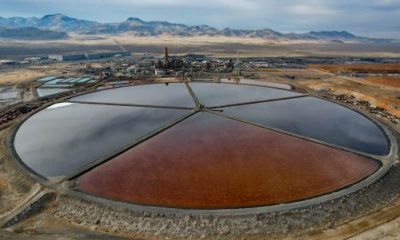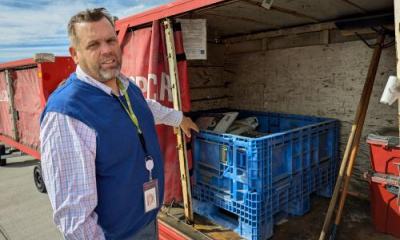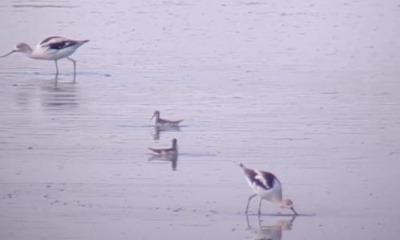Wildlife managers already maintain hundreds of thousands of acres of artificial wetlands around the Great Salt Lake. But as the lake shrinks, the opportunity to build more grows
IMPERIAL COUNTY, Calif. — Not everyone gets to turn their hobby into a career. But thanks to the Salton Sea, California duck hunting guide Breck Dickinson gets to do just that. He doesn’t even advertise, and yet he has work booked out years in advance.
Declining water levels at the Salton Sea, which has lost about a third of its water supply in the past 25 years, jeopardize the future of his business. The ducks remain plentiful, he says, but access to the lake has declined and other species of birds have largely disappeared.
“For one thing, there are no more brown pelicans here,” Dickinson says. “They used to be here. The Salton Sea used to have fish in it ... but those big algae blooms choked out all the oxygen and they died.”
All that could change within the next year or two as the state of California nears the completion of the Species Conservation Habitat Restoration Project. The primary goal of the project, according to Samantha Arthur, assistant secretary for Salton Sea policy for the California Natural Resources Agency, is to restore habitat for the endangered desert pupfish. But it’s just the first step in California’s plans to restore 30,000 acres of habitat at the Salton Sea — and one that could have implications for the future of the Great Salt Lake.
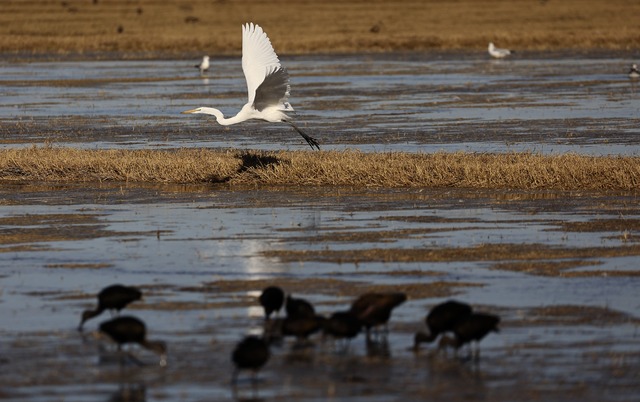
A great egret flies near the Sonny Bono Salton Sea National Wildlife Refuge in Imperial County, Calif., on Friday, Dec. 15, 2023. Kristin Murphy, Deseret News
Home for fish, food for birds
The loss of water from the Salton Sea — which is primarily a result of changes in water policy that reduced the agricultural runoff that once fed the lake — has created significant difficulties for human access to the lake. As the shore has receded, it has left in its wake a crust that conceals sticky mud beneath it. It might look like you could drive across it to reach what remains of the lake, Dickinson says, but if you do it’s “like driving on a giant pie. ... You will punch through the crust and it’s all pudding underneath.”
But for wildlife, rising salinity presents the greatest challenge, according to Vivien Maisonneuve, Salton Sea Management program manager at the California Department of Water Resources. Like the Great Salt Lake, the Salton Sea is a terminal lake, which means that the water and salts it contains have nowhere else to go. As the sea shrinks, the salt becomes more concentrated, raising the salinity to about 7% today. Ocean water is about 3.5% salt by weight; the Great Salt Lake ranges from 5%-27%
The increased salinity of the Salton Sea means it can no longer support fish, which has in turn impacted species such as the brown pelican that rely on fish as a source of food, Maisonneuve says.
To combat this, he says, the state of California plans to pump water from a nearby river and mix it with water from the Salton Sea to achieve the ideal salinity. The mixed water will be used to fill man-made basins dug into the Salton Sea shoreline to create an artificial wetland — or what the ecology pros like to call a managed wetland. California habitat managers will have the ability to adjust the water levels and salinity in the wetland to keep it within the ideal range for the desert pupfish, Maisonnueve says. And as the fish return, the shorebirds who once frequented the Salton Sea should as well.
The New River diversion structure is pictured in the Species Conservation Habitat Project by the Salton Sea in Imperial County, Calif., on Wednesday, Dec. 13, 2023. The structure will divert New River water to basins where it can be mixed with water pumped from the Salton Sea, enabling control over salinity concentrations in the habitat’s ponds. The Species Conservation Habitat Project will turn over 4,000 acres of exposed lake bed into wetlands habitat for aquatic wildlife and migratory birds of the Pacific Flyway, as part of a 10-year plan to restore 30,000 acres around the Salton Sea.
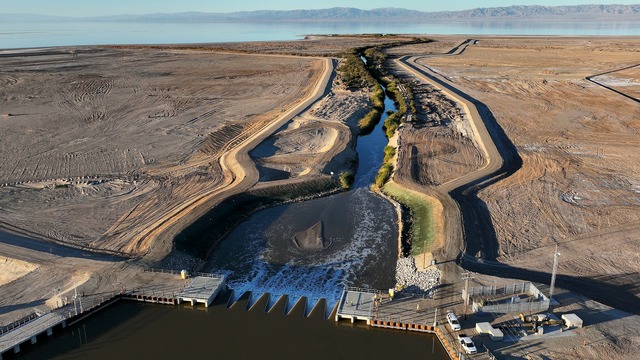
The New River diversion structure is pictured in the Species Conservation Habitat Project by the Salton Sea in Imperial County, Calif., on Wednesday, Dec. 13, 2023. The structure will divert New River water to basins where it can be mixed with water pumped from the Salton Sea, enabling control over salinity concentrations in the habitat’s ponds. The Species Conservation Habitat Project will turn over 4,000 acres of exposed lake bed into wetlands habitat for aquatic wildlife and migratory birds of the Pacific Flyway, as part of a 10-year plan to restore 30,000 acres around the Salton Sea. | Kristin Murphy, Deseret News
Opportunities for wetland habitat
Managed wetlands are nothing new to the Great Salt Lake. Between projects operated by the federal government, the state of Utah, and various private entities such as duck clubs and conservation groups, the lake’s shoreline already features some 300,000 acres of managed wetlands, according to Max Malmquist, engagement manager for the National Audubon Society’s Saline Lakes Program. Some of these wetlands date back to an effort in the 1930s to control the spread of botulism in area waterfowl, says Adam Wickline, senior project manager for the Great Salt Lake Watershed Enhancement Trust, which is co-managed by Audubon and The Nature Conservancy.
But like the Salton Sea, the Great Salt Lake might benefit from an expanded network of managed wetlands should the lake continue to shrink in the future.
As the lake recedes, the distance between what we’d normally consider the end point of the fresh water rivers that feed it, and the shore of the lake itself grows, Malmquist says. This is creating larger wetland-like areas in areas once covered by the lake itself. And while most of these areas aren’t currently managed for the express purpose of providing habitat for birds, Audubon has observed that these growing deltas tend to attract shorebirds.
“If the lake level stays low, the amount of habitat that it provides may change,” Malmquist says. “If we are looking to maximize or improve habitat for birds, we may want to start looking at those freshwater-saltwater interfaces to see what can be done to create more habitat at those locations.”
This would also have the added benefit, Malmquist says, of helping to control dust that may blow off the exposed lakebed — a benefit that California also expects to see from its wetland projects at the Salton Sea.
But it would also come with some likely tradeoffs, Malmquist says. What makes the Great Salt Lake unique is the great diversity of habitat it provides for all manner of birds — from the lake itself, with its brine flies and brine shrimp, to the surrounding wetlands and their different kinds of vegetation, bugs and invertebrates. Where one group of waterfowl might rely on the wetland for food, another — such as the eared grebe — needs the open lake and the brine shrimp.
“One of the things we are seeing at the Salton Sea is because the lake levels are declining, we are seeing winners and losers there. The fishing birds that are without fish, they are the losers in this case. But these other habitats are appearing and are providing additional resources for species in habitats that probably occurred historically at the Salton Sea,” Malmquist says. “What we observe at the Salton Sea is something we can look at here as conditions change to inform what habitat is provided, what water is provided.”
So while a shrinking lake might open up more opportunities for wetland habitat, the current goal, Malmquist says, is to ensure the lake has adequate water to support all the habitats it currently represents.

Dakota Ball, MWH Constructors Inc. manager, and Vivien L. Maisonneuve, program manager at the California Department of Water Resources' Salton Sea Management Program, inspect pipes that are used to pump water from the Salton Sea into ponds for the Species Conservation Habitat Project in Imperial County, Calif., on Wednesday, Dec. 13, 2023. The water will be mixed with water from the New River, enabling control over salinity concentrations in the habitat’s ponds. | Kristin Murphy, Deseret News



